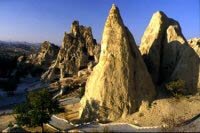
Cappadocia
Cappadocia is the name of the region in central Anatolia. Back in ancient times Cappadocia referred to a large territory, extending to Armenia and Aeksinian harbour on the Black Sea in the north. What is nowadays called Cappadocia borders upon the town of Aksarai in the west, Nowhere (cool name, isnТt it?) in the south, Kaiseri in the East, Kirshehir in the north. Some spots of this terrain are referred to as Cappadocia more often, then others, as they are centres of tourist attraction. They lie within a triangle, formed by three cities: Avanos, Nevshehir, Urgup.
There are some good sites on the net describing Cappadocia. Here are some links to them:
CAVETOWNS
AND GORGES OF CAPPADOCIA
Cappadocia lies to the south of mountains Argaeus (Argaeus, 3916 m) and Hasandage (Hasandage, 3268 m). These are extinct volcanoes, the eruption of which has covered the area around with a thick layer of volcanic dust. Later, the erosion of the tuff formed fantastically shaped mountains (see photo) rich in caves (see here, e.g.). One of the most common shapes found are so-called УconesФ, rocks which have a form of a pyramid. These are the type of rocks where the men-cut settlement caverns are most frequently found. Often these cones have a kind of a УcapФ on top Ц a giant rock of a different colour, which make them look like mushrooms. For instance, see following photos. This is how the local authorities introduce Cappadocia on their web-site.
This kind of structures are called Уfairy chimneyФ in English.
The area has quite an interesting history. At first, Cappadocia was the Accyrian colony, then the centre of Hittites State (wonder, if these were the same Hittites), of which is known very little. Then Cappadocia was under domination of Persia, then came Alexander the Macedonian. Cappadocia was an independent nation with a culture, written language and royal dynasty of its own, it has submitted to Roman Empire only (not counting the barbarian conquerors). Little by little Roman forced out the local authorities and in the year 17th Tiberius has reduced Cappadocia to one of the the Roman Empire provinces. It was in that time that the main city Macaka was given the name of Caesarea, Kayseri at present. Christianity spread quickly to this region (Ankara was the Halatia, for the commune of which St. Paul wrote; and St. Peter mentions Cappadocia in his writings). In the third century the region has become one of the main centres of Christianity (on that refer to УChristianity in CappadociaФ, but thatТs more about pholosophy, then about history). During the fourth century the famous У Cappadocia fathersФ : St Basil the Great (refer to his hagiagraphy), his brother, St. Gregory Nissky, and St. Gregory the Theologian (Nasiansus) lived and fought with Arianism here. Among other, St. Basil and St. Gregory the Theologian composed the set of rules for regulatation of the Enoch community life. Enochs of the Eastern Church follow these rules still.
A great number of monks used to settle down in valleys of the region, often cutting out caverns for their cloisters. Some of these cloisters are inaccessible still, with an almost vertical hundred-step climb to the top of the mountain, for instance, climbing to the fifth step being a challenge.
ItТs fairly possible though, that not all of the caverns were cut out by monks to serve as cloisters. These coves could have served as hide-outs for refugees, soldiers, peasants, fleeing from Arabic raids.
The army of Byzantine was defeated by Seljuk Turks in 1071. By the end of the decade the Turks have already conquered the greater part of Asia Minor, including Cappadocia. The capital city was now Honia. The Seljuk Turks were rather tolerant towards Christianity, so the cloisters could have well existed under their rule. The broke-off of the relations with Constantinople and the rest of the Christian world, however, has caused the abandonment of cloisters, as the communities have ceased to exist. The cloisters would later be used by peasants as store room.
Some of the cloisters were active up until 1923, when the war between Greece and Turkey broke off. As a result of ethnic purge the Greeks and the Turks were either sent out to their home countries.
Focus
online: Cappadocia
Pictures
of one traveler
CMB
Tours: CAPPADOCIA
A very good collection of the photos of the mountains
Cappadocia:
Epoch by Epoch (a good history article)